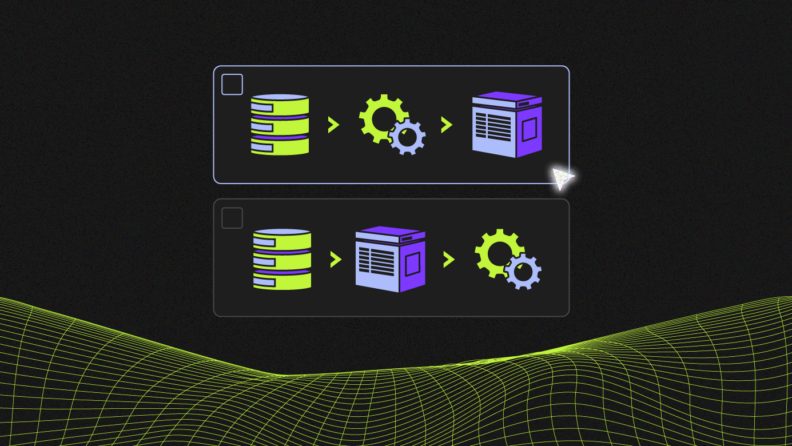Do you know the difference between ETL and ELT? Hint: It’s not that one’s a typo.
ETL stands for Extract, Transform, and Load, and ELT stands for Extract, Load, and Transform. They’re both ways of taking data from multiple source systems and uploading it into a target data warehouse. However, the main distinction is the point at which data transformation occurs, and that subtle change can make a massive difference in the process. As cloud computing has become more popular, we’ve seen a move toward cloud-based data warehouses and increasing interest in ELT compared to ETL.
I’ve explored useful ETL tools previously. In this article, I'll discuss ELT, its role in big data analytics, and when to consider using this method over ETL.
What is ETL (Extract, Transform, Load)?
In ETL pipelines, data is extracted from one or more data sources before being cleaned, sanitized, and standardized as part of a data transformation process. Finally, the data is loaded into the target system.
Sometimes, the data is fed into a staging system after transformation but before loading, although this is optional. ETL has been in use since the 1970s and works well for batch processing large volumes of data, centralizing it, and performing deep and complex analytics on that data.
What is ELT (Extract, Load, Transform)?
ELT is similar to ETL in that data is pulled from APIs, relational databases, or various unstructured or semi-structured data sources. The difference is what happens next. Instead of being transformed immediately, the data is loaded into a warehouse and then transformed.
The ELT process has several benefits over ETL. First, it’s faster, as the data is simply fed to the data warehouse, where it can be processed at any time. Second, it’s more versatile.
ETL works best with structured data. It can be used with unstructured data, but a lot of planning is required to standardize that data into a format the database can hold. ELT can load all kinds of data formats, and data scientists can transform the data once it’s loaded, giving them more flexibility in terms of the queries they can perform.
How is ETL Different from the ELT Process?
Changing the order in which the transformation and loading processes are performed may seem like a minor alteration, but it makes a big difference in how fast the process is and which use cases it’s suitable for.
Cloud service providers often have their own tools for automating ELT, making data protection and other aspects of regulatory compliance a simpler process. These benefits lead many organizations to use ELT to handle their data sets.
Side-by-Side Comparison
Let’s consider ELT vs ETL side by side:
| Speed | In most cases, ELT is faster than ETL |
| Scalability | As a cloud-centric solution, ELT has greater scaling potential than ETL |
| Data Quality Management | By pre-transforming the data, ETL offers better data quality management |
| Cost | The relative costs depend on the tools and infrastructure used to extract, transform, and load data |
| Complexity | The requirement to process the data before loading means ETL is more complex than ELT, especially when dealing with varied data structures or unstructured data that require complex transformations |
| Transformation Location | With ETL, the transformation occurs on a processing server before data is loaded to a staging area. With ELT, the data is transformed in the target data warehouse. |
| Security and Compliance | Many ETL tools offer solutions to help with HIPAA and GDPR compliance, making the more mature process an easy choice. However, cloud computing providers are also working on integrating compliance into their ELT solutions |
Which is Better: ETL or ELT?
ELT and ETL are valuable tools in a data analyst’s toolchain. Which workflow you choose will depend on the type of data being collected, the needs of your project, and the infrastructure you have access to.
If most of your data is in structured form and held on an on-premises server, you may feel more comfortable doing your own data cleansing and transformation. In contrast, if you’re handling data from numerous sources, taking advantage of the speed and flexibility of ELT could make sense.
Both ETL and ELT have the end goal of loading data from multiple data sources into a central database, and many data warehouse tools can assist with this. Tools with ETL in mind may have more compliance features and baked-in support for legacy databases. With that said, the ELT ecosystem is growing rapidly, too.
When choosing the right process to unify and transform data in your organization, consider the volume and velocity of that data and the type of analytics you plan to perform. This will help you make an informed decision.
Final Thoughts
Things move quickly in the world of data management and storage. ELT is fashionable today because it’s an effective way of dealing with the sheer volume and velocity of data that many organizations handle. Thanks to the scalability and power of cloud computing, ETL is now a practical approach to data processing.
But that doesn’t mean ETL is obsolete. Data custodians cannot afford to ignore regulatory requirements, and those who perform complex analytics regularly may still prefer to know their data has been sanitized, de-duplicated, and properly processed before being loaded into their data lake.
As a technology leader, it’s your role to consider the pros and cons of each approach and ensure that however you process your data, you follow your data governance procedures, maintain regulatory compliance, and provide your teams with the information they need to get actionable business insights.
For more on data processing, security, and other emerging technology topics, subscribe to the CTO Club newsletter today.




